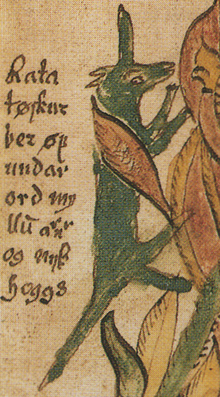Ratatosk
In Norse mythology, Ratatösk or Ratatoskr (in Old Norse, generally referred to as "drilling tooth" or "drilling tooth") is a squirrel that he runs up and down the world tree Yggdrasil carrying messages between the nameless eagle, perched on the top, and the dragon Níðhöggr, who resides under one of the tree's three branches. An account of Ratatösk is given in the Poetic Edda, compiled in the 13th century from older traditional sources. early, and in the Prose Edda, written in the same century by Snorri Sturluson. Various scholars have proposed theories about the squirrel's implications.
Etymology
The name Ratatösk consists of two elements: rata- and -tosk. The latter is mostly believed to mean "fang". Guðbrandur Vigfússon theorizes that the element rati- means "the salesman". Vigfússon claims that the name of the legendary Rati drill could present the same term. According to Vigfússon, Ratatösk means "the traveling fang" or "the climbing fang".
Sophus Bugge in turn theorizes that the name Ratatösk is an Old English loanword meaning "Rat-tooth". This theory is based on the fact that the -tosk element of the compound does not appear anywhere else in Old Norse. Bugge proposes that this element is a reformation of the Old English word tūsc (Old Frisian tusk) and that, instead, the element Rat- represents the Old English word ræt ("rat").
According to Albert Sturtevant, "As regards the element Rat-, Bugge's hypothesis has no valid foundation in view of the fact that the [Old Norse] word Rat (form of Rati*) is used in Háv[amál] (106, 1) to name the instrument used by Odin to pierce through the rocks in search of the mead of the poets [...]", and that "Rati* should be considered a native word [in Old Norse] meaning "the borer, rodent" [...]».
Sturtevant explains that Bugge's theory of the -tosk element seems to be supported by the fact that the word does not appear anywhere else in Old Norse. However, he disagrees with this theory, as he states that the Old Norse proper name Tunne (derived from Protonorse *Tunþē) refers to "a person who is characterized as carrying a peculiar kind of tooth", and speculates a Proto-Germanic form of -tosk. Sturtevant concludes that “the fact that the word occurs only in the name Rata-toskr is not valid evidence against this assumption, since there are many hapax legomena of native origin [ in Old Norse], as attested in modern Scandinavian dialect equivalents". Modern scholars have accepted this etymology, leaving Ratatösk meaning "boring tooth", such as Jesse Byock, Andy Orchard, and Rudolf Simek, or "drilling tooth", like John Lindow.
Testimonials
In the poem Grímnismál from the Poetic Edda, the god Odin (disguised as Grímnir) states that Ratatösk runs up and down the tree Yggdrasil carrying messages between the eagle on the cup and Níðhögg at its roots:
- Approximate translation based on Benjamin Thorpe:
- Ratatösk is called the squirrel, which runs
- in the mill Yggdrasil;
- from above the words of the eagle must bear,
- and under Nidhögg repeat them.
- Approximate translation based on Henry Adams Bellows:
- Ratatosk is the squirrel that must run there
- In the mill Yggdrasil;
- From above the words of the eagle carry,
- And you tell Nithhogg below.
In the book Gylfaginning of the Prose Edda, Ratatösk is mentioned in chapter 16. In it, Gangleri (described as King Gylfi in disguise) asks There are other notable facts to know about Yggdrasil. Hár's statement agrees with that of Grímnismál, but adds that the messages are slanderous gossip:
There's a lot to tell. An eagle lies in the bowl of ash, and has knowledge of many things. Among his eyes lies the falcon called Vedrfolnir [...]. The squirrel called Ratatosk [...] runs from top to bottom of the ash. It exclaims slanderous gossip, causing the eagle and Nidhogg.
Theories
According to Rudolf Simek, "the squirrel probably only represents a decorative detail of the mythological image of the world ash in Grímnismál". H. R. Ellis Davidson, describing the world tree, states that the squirrel also gnawed on it, which continues the cycle of destruction and reconstruction, and proposes the tree as a symbol of constant existential change. John Lindow notes that Yggdrasil is described as rotten on one side and chewed by four deer and by Nídhögg, and who, according to the story of Gylfaginning, also endures the verbal hostility that the fauna he maintains inflicts on him. Lindow adds that "in the sagas, a person who helps stir up and keep disputes alive by carrying malicious words between the parties is rarely someone of high status, which would explain why this role in mythology was assigned to a relatively insignificant animal."
Richard W. Thorrington Jr. and Katie Ferrell in turn propose that "Ratatosk's role probably derived from the habit of European tree squirrels (Sciurus vulgaris) of having a confrontational response to danger. It doesn't take much imagination to think that the squirrel is saying ugly things about you."
Contenido relacionado
Aphrodite
Astaroth
Melia

